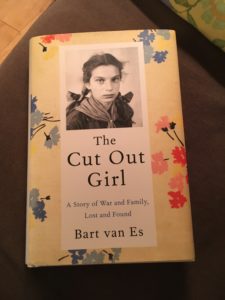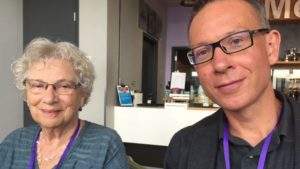
The ineptly titled “The Cut Out Girl: A Story of War and Family, Lost and Found” by Bart van Es is foremost the gripping and complex story of a Jewish girl hidden in plain sight in the bosom of the author’s grandparents’ family. Over her story is laid the equally complicated tale of this host family, and how little the author knows of what happened among them under the Nazi occupation. In the course of the book, the “cut out girl” Lien de Jong and the author Bart form a collaboration and friendship, and we see how the story is pieced together. Their conversations in her Amsterdam apartment interlace his journeys to her hiding places and various archives and experts. The two come to understand, at least to some extent, how the rift between Lien and the people who helped to save her could have happened in the 1980s.
Bart de Es does an admirable job of evoking moments, in a breathless, present tense style that shows how the potatoes are served at the family table, or how a ball rolls into the woods. He tells the reader that he has embellished the fragments Lien provides in their extended conversations, stirring in just enough egg to hold the dough of her memories together, and checking with her for accuracy. Although he left the Netherlands for England when he was only three years old, de Es spent many summers there and has a real feeling for the landscape, which he conveys in detail. However, he learns that it is actually full of hidden secrets which come closer and closer to his own people.

As background to the personal stories, de Es provides compact, well researched (although not footnoted) accounts of key events that will influence the fates of the characters: his speculation about why 75% of Dutch Jews were rounded up and murdered, the bombing of the countryside and the “bridge too far,” how the survivors were treated when they emerged from hiding or the camps, and more. Occasionally, the reader is in the same numbed and disoriented state Lien is experiencing, unsure what age she is, which village we are in, who that character is, and what’s happening in the bigger picture. But de Es usually gets the balance right, painting the background in with just enough strokes to make it visible. His lengthy descriptions of photographs sometimes feel excessive, but he nearly always points out details that all but the most studious reader would miss. Most are reproduced at such a small size that a glass would be needed to see what de Es has noticed.
Like any book on this theme, there are heart-wrenching moments, and they are never overplayed. I will never forget the letter Lien’s mother writes to the family who will hide her daughter. de Es gets it just right when he speaks of the tone of “measured sacrifice” as she expresses the wish that her hidden daughter think of her new family as her parents, and turn to them for comfort in “the moments of sadness that will come to her”. Although Lien’s mother closes with the wish that they will all be reunited one day, she is making other provisions.

Although skimpy in recounting his own emotional reactions – undoubtedly better than overdoing it as most American writers might have done – de Es deserves great credit for recounting Lien’s feelings in a way that seems accurate and honest to her. That shows particular bravery in the case of the sexual abuse she was subjected to, including inappropriate attention from the author’s grandmother. de Es finally is struck by the thunderbolt of connection between her life and his – not only the link with his grandparents who sheltered her, but between his biography and hers. Grappling with a rebellious teenaged daughter, he recognizes Lien’s “free fall” at the same age, and sees his strict grandmother in himself. He also discovers much more, which changes his view of his childhood and perhaps the Dutch identity: “My sense of the one village in the Netherlands that I thought I knew has changed.”
As someone who spent 13 years researching and writing about this place and time to produce An Address in Amsterdam, I empathized with de Es’s poignant question “What could I add?” as he scrutinized the piles of books about World War II. But add he has, at least in the English language. This book gives us an intricate picture of the “before, during and after” for a hidden child and those who both helped and hindered her. “The Cut Out Girl” records the profound damage to all the survivors (hidden, Jewish and others), and is a tribute to resilience and the ability to throw lines of connection across the wounds.
